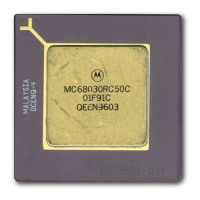Data Organization and Addressing Capabilities
2-4
MC68030 USER’S MANUAL
MOTOROLA
2.2.2 Address Registers
Each address register and stack pointer is 32 bits wide and holds a 32-bit address. Address
registers cannot be used for byte-sized operands. Therefore, when an address register is
used as a source operand, either the low-order word or the entire long-word operand is
used, depending upon the operation size. When an address register is used as the
destination operand, the entire register is affected, regardless of the operation size. If the
source operand is a word size, it is first sign-extended to 32 bits and then used in the
operation to an address register destination. Address registers are used primarily for
addresses and to support address computation. The instruction set includes instructions
that add to, subtract from, compare, and move the contents of address registers. The
following example shows the organization of addresses in address registers.
Address Organization in Address Registers
2.2.3 Control Registers
The control registers described in this section contain control information for supervisor
functions and vary in size. With the exception of the user portion of the status register (CCR),
they are accessed only by instructions at the supervisor privilege level.
The status register (SR), shown in Figure 1–4, is 16 bits wide. Only 12 bits of the status
register are defined; all undefined values are reserved by Motorola for future definition. The
undefined bits are read as zeros and should be written as zeros for future compatibility. The
lower byte of the status register is the CCR. Operations to the CCR can be performed at the
supervisor or user privilege level. All operations to the status register and CCR are word-
sized operations, but for all CCR operations, the upper byte is read as all zeros and is
ignored when written, regardless of privilege level.
31 16 15 0
Sign-Extended 16-Bit Address Operand
31 0
Full 32-Bit Address Operand

